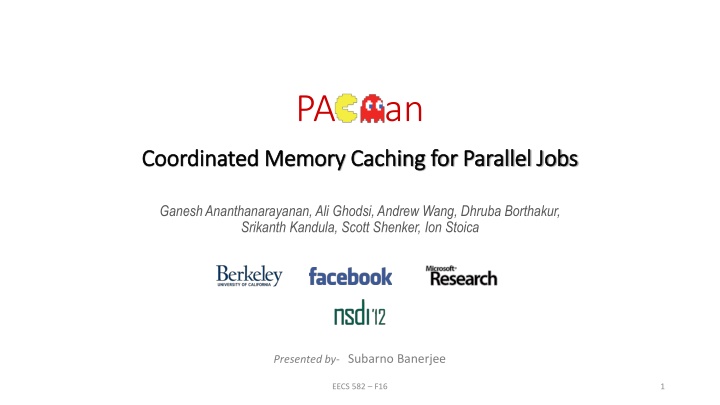
Coordinated Memory Caching for Parallel Jobs
Explore the implementation of PACMan, a Parallel All-or-nothing Cache Manager, in managing distributed memory caches for parallel jobs. The system coordinates access and globally mediates cache replacement across machines, optimizing performance and resource utilization in datacenter environments.
Download Presentation

Please find below an Image/Link to download the presentation.
The content on the website is provided AS IS for your information and personal use only. It may not be sold, licensed, or shared on other websites without obtaining consent from the author. If you encounter any issues during the download, it is possible that the publisher has removed the file from their server.
You are allowed to download the files provided on this website for personal or commercial use, subject to the condition that they are used lawfully. All files are the property of their respective owners.
The content on the website is provided AS IS for your information and personal use only. It may not be sold, licensed, or shared on other websites without obtaining consent from the author.
E N D
Presentation Transcript
PA an Coordinated Memory Caching for Parallel Jobs Coordinated Memory Caching for Parallel Jobs Ganesh Ananthanarayanan, Ali Ghodsi, Andrew Wang, Dhruba Borthakur, Srikanth Kandula, Scott Shenker, Ion Stoica Presented by- Subarno Banerjee EECS 582 F16 1
Motivation Motivation Jobs Scheduler EECS 582 F16 2
Motivation Motivation Heavy-tailed Input Sizes of Jobs 96% of Facebook s smallest jobs account for 10% overall data Input data of most jobs can be cached in 32GB of memory 96% of jobs in Facebook s Hadoop cluster fit in memory Popularity Skew EECS 582 F16 3
Motivation Motivation IO-intensive phase constitute significant portion of datacenter execution 79% of runtime, 69% of resource + Majority of jobs are small in size + Popularity skew || In-Memory Caching EECS 582 F16 4
PACMan PACMan: : Parallel All-or-nothing Cache Manager PACMan Coordinator Globally coordinates access to its distributed memory caches across various machines PACMan Client PACMan Client PACMan Client Two main tasks: Support queries for the set of machines where block is cached Mediate cache replacement globally across machines DFS Slave DFS Slave DFS Slave DFS Master EECS 582 F16 5
PACMan PACMan Coordinator Coordinator PACMan Coordinator Keep track of the changes that are made by clients. Maintain a mapping between every cached block and the machines that cache it. PACMan Client PACMan Client PACMan Client DFS Slave DFS Slave DFS Slave Implements the cache eviction policies such as LIFE and LFU-F Secondary coordinator on cold standby as a backup. DFS Master EECS 582 F16 6
PACMan PACMan Client Client PACMan Coordinator Service requests to existing cache blocks and manage new blocks. PACMan Client PACMan Client PACMan Client Data is cached at the destination, rather than the source DFS Slave DFS Slave DFS Slave DFS Master EECS 582 F16 7
Insight: All All- -or or- -Nothing Nothing Property Tasks of small jobs run simultaneously in a wave Task duration (uncached input) Task duration (cached input) slot1 slot1 slot1 slot2 slot2 slot2 time time time completion time completion time completion time All-or-nothing: Unless all inputs are cached, there is no benefit EECS 582 F16 8
Insight: All All- -or or- -Nothing Nothing Property All-or-nothing property matters for efficiency as well Task duration (uncached input) Task duration (cached input) Map Idle Read Read Compute Read Compute Reduce Read Compute Idle Read Read Compute time time EECS 582 F16 9
Problems with Traditional Policies Problems with Traditional Policies Simply maximizing the hit-rate may not improve performance E.g. If we have Job 1 and Job 2 where Job 2 depends on result of Job 1 Task duration (uncached input) Task duration (cached input) Job 1 Job 2 Job 1 Job 2 Sticky Policy: Evict the Incomplete Files first. slot1 slot2 slot3 slot4 slot1 slot2 slot3 slot4 Job 2 completion Job 1 completion Job 1 completion Job 2 completion EECS 582 F16 10
Eviction Policy Eviction Policy - - LIFE LIFE Goal: Minimize the average completion time of jobs largest file with largest wave-width Are there any Incomplete Files? Wave-width: Number of parallel tasks of a job YES NO Evict largest Incomplete File Evict largest Complete File EECS 582 F16 11
Eviction Policy Eviction Policy LFU LFU- -F F Goal: Maximize the resource efficiency of the cluster (Utilization) Are there any Incomplete Files? YES NO Evict least accessed Incomplete File Evict least accessed Complete File EECS 582 F16 12
Eviction Policy Eviction Policy LIFE vs LFU LIFE vs LFU- -F F Job 1 Wave-width: 3 Job 2 Wave-width: 2 Capacity: 3 Capacity: 4 Frequency: 2 Frequency: 1 LIFE: Evict the highest wave-width LFU-F : Evict the lowest frequency slot1 slot2 slot3 slot1 slot2 slot3 Job 1 Job 1 slot4 slot5 slot4 slot5 Job 2 Job 2 Capacity Required: 3 Capacity Required: 4 EECS 582 F16 13
Evaluation Evaluation Experimental Setup: 100-node cluster in Amazon EC2 34.2GB of memory, 20GB of cache allocation for PACMan per machine 13 cores and 850 GB storage Traces from Facebook and Bing EECS 582 F16 14
Results: Results: PACMan on Hadoop Significant reduction in completion time for small jobs. Better efficiency at larger jobs. EECS 582 F16 15
Results: Results: PACMan vs Traditional Policies LIFE performs significantly better than MIN, despite having lower hit ratio for most applications. Sticky-policy help LFU-F have better cluster efficiency. EECS 582 F16 16
Takeaways Takeaways Most datacenter workloads are small in size, and can fit in memory. PACMan Coordinated Cache Management System Take into account All-or-nothing nature of parallel jobs to improve: Completion Time (LIFE policy) Resource Utilization (LFU-F policy) 53% improvement in runtime, 54% improvement in resource utilization over Hadoop. EECS 582 F16 17
Reviews Reviews All-or-nothing Reduces completion time Significant performance gain Wave-based execution Increases cluster efficiency Theoretical analysis Coordination architecture independent of replacement policy Fairness? No Prefetching Overheads Wave-width approximation Communication overhead with scheduler for prefetching Generalize to other parallel workloads? More policies ? Scalability? >10 tasks per machine? Single coordinator bottleneck? Reliability? Clients become uncooperative Fault tolerance? Coordinator failure recovery is slow Priority inversion? Long running jobs suffer due to many small jobs EECS 582 F16 18
Discussion Discussion Should PACMan be scaled down to coordinate shared cache management for multicore processors ? Are there distributed workloads where the all-or-nothing property does not hold ? PACMan assumes remote memory access is constrained by the network. How does RDMA affect PACMan s design ? EECS 582 F16 19
Results: Results: PACMan s Scalability PACMan client saturate at 10-12 tasks per machine, for block sizes of 64/128/256MB, which is typical of Hadoop Coordinator maintains a constant ~1.2ms latency till 10,300 requests per second; Hadoop handles 3,200 requests/s EECS 582 F16 20
Results: Results: PACMan s sensitivity to Cache Size Both LIFE and LFU-F react gracefully to reduction in cache size. At 12GB cache- LIFE yields 35% reduction in completion time, LFU-F yields 29% improvement in cluster efficiency EECS 582 F16 21


